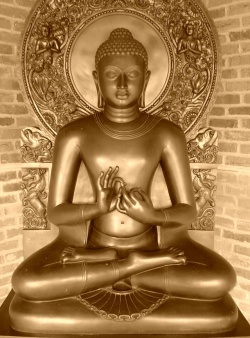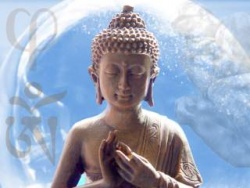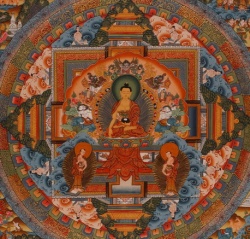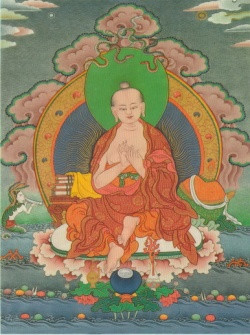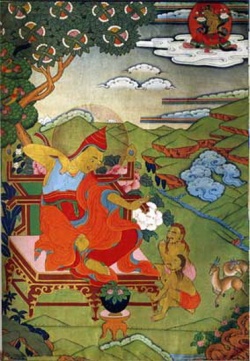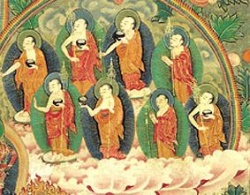Yogacara Buddhism and Sartre’s Phenomenology by Chan, Wing-cheuk
The problem of whether Yogacara Buddhism is idealistic has become a focal topic in Western scholarship. An idealistic interpretation of Yogacara Buddhism usually finds its justification in the famous slogan of the Samdhinirmocana sutra that “the object of consciousness is the manifestation of consciousness only.” In fact, many Indian scholars simply translate “vijnaptimatrata” or “vijnanavada” as “idealism.” For example, A. K. Chatterjee’s work on Yogacara Buddhism was entitled The Yogacara Idealism. Even nowadays, in Japan such an idealistic understanding of Yogacara is still dominant. On the other hand, Yoshifumi Ueda proclaims a non-idealistic interpretation of Yogacara Buddhism. Besides, Lambert Schmithausen and Alex Wayman have argued for the thesis that the early Yogacra Buddhism is not idealistic.
This line has been followed by Dan Lusthaus. In this paper, in terms of a comparison with Sartre’s phenomenology, we will clarify Ueda’s basic position. This will not only phenomenologically justify Ueda’s critique of Dharmapala’s doctrine of internal objects, but also indicate how Yogacara Buddhism can help Sartre to overcome the dualist predicament. Key words ∗ Associate Professor, Humanities Research Institute of Brock University
Lambert Schmithausen
Yogacara Buddhism and Sartre’s Phenomenology 129 Yogacara Buddhism and Sartre’s Phenomenology The problem of whether Yogacara Buddhism is idealistic has become a focal topic in Western scholarship.
An idealistic interpretation of Yogacara Buddhism traditionally finds its justification in the famous slogan of the Samdhinirmocana sutra that “the object of consciousness is the manifestation of consciousness only.”1 In fact, many Indian scholars simply translate “vijnaptimatrata” or “vijnanavada” as “idealism.” For example, A. K. Chatterjee’s work on Yogacara Buddhism was entitled The Yogacara Idealism. 2 Even nowadays, in Japan such an idealistic understanding of Yogacara is still dominant. In particular, following E. Frauwallner, Y. Kajiyama explicitly wrote: “According to such an idealistic doctrine, the existing defiled world is originally absolutely pure. It is because our mind is covered by the contingently arising dirt, then there appears the image….This doctrine identifies the phenomenal world as the image of our mind and hence declares it to be empty [[[sunya]]]. Such a position constitutes the starting point of the philosophy of this school. In other words, although the phenomenal world is empty [[[sunya]]], the mind remains as the original reality.
The phenomenal world is only the image of our mind.” 3 On the other hand, some Western scholars like Lambert Schmithausen and Alex Wayman have tried to argue for the thesis that the early Yogacra Buddhism is not idealistic.4 This line has been followed by Dan Lusthaus. 5 1 T, vol. 76, p.698. 2 A. K. Chaterjee, The Yogacara Buddhism. Delhi: 1962. 3 Y. Kajiyama, “‘Yuishiki Sanjuju ron’ kaisetu,” in G. Nagao et. al. (eds.) Seshin ronshu. Tokyo: 1976, p.414. 4 Cf.: L. Schmithausen, Alayavijnana: On the Origin and the Early Development of a Central Concept of Yogacara Philosophy. Tokyo: 1987; A. Wayman, “The Yogacara Idealism” (Review Article), Philosophy East and West, vol. 15 (1965), pp.65-73; A. Wayman, “A Defense of Yogacara Budhhism, Philosophy East and West, vol. 46 (1996), pp.447-476. 5 Cf.: Dan Lusthaus, Buddhist Phenomenology: A Philosophical Investigation of Yogacara Buddhism and the Cheng Wei-shih lun. New York: Routledge Curszon, 2002. 130 In the historical development of Buddhism, the Yogacara School is unique in expounding its doctrine of vijnaptimatra. The term “vijnaptimatra “has been literally translated as “There is no object, there is consciousness only.”
On the other hand, Yogacara Buddhism claims that “The object of consciousness is nothing but its manifestation.” In combining these two positions together, the rise of Dharampala’s idealistic turn seems to be the only logical solution in dispelling any paradoxical consequence of Yogacara Buddhism. Dharmapala made a distinction between two types of object. While one is called the external object, the other is called the internal object. The external object is outside consciousness, whereas the internal object is inside consciousness. Dharmapala argued that it is only the existence of the external object which is to be denied by the Yogacara School. In contrast, as the result of manifestation of the substratum consciousness, the existence of the internal object must be affirmed. Such an idealistic trend had been followed by the Fa Hsiang School which was founded by Hsuan Tsang and K’eui Ch’i in China. Traditionally, the Fa Hsiang School has been identified as the orthodox school in Yogacara Buddhism. According to Yoshifumi Ueda, such an ontological turn in the later development of Yogacara Buddhism has two drawbacks. First, it falsifies the original position of Maitreya, Asanga and Vasubandhu.
For in its early development, Yogacara Buddhism is primarily an epistemology, rather than ontology in the sense of a theory of the origin of the world. That is to say, the original concern for Yogacara Buddhism was to see how the world is given to us, rather than why the world exists. Ueda insists that the Old School represented by Sthiramati and Paramartha is non-idealistic. Second, in turning into idealism, Yogacara Buddhism Yogacara Buddhism and Sartre’s Phenomenology 131 might be in crash with the Madhyamika. 6 The famous controversy between Bhavaviveka and Dharmapala can confirm this kind of tension. After rejecting Dharmapala’s concept of the internal object, it is necessary for Ueda to account for the possibility of the known object. At this juncture, Ueda declared that “if there is no objectification of consciousness, there is no object.” 7 He even claimed, “To say that the object of consciousness is nothing but consciousness only is to say that consciousness sees itself.” 8 Paradoxically, “The possibility of such self-seeing must be grounded in its self-negation.” 9 That is to say, “Such seeing points to the fact that it is only when [[[consciousness]]] negates itself, then it can see itself au detour de seeing its object. (Accordingly, in such a way the seen object is not non-existent, but rather existent.)” 10 To this extent, one can say that “If consciousness does not negate itself, then no object can arise.” 11 At first glance, such a kind of speech of “objectification of consciousness” and “self-negation of consciousness” is highly idealistic.
First of all, it resembles the position of German Idealism. As is well-known, German Idealism declares that the world basically results from the self-objectification of spirit. But Ueda categorically denied that the authentic position of Yogacara Buddhism is idealistic in the above sense.12 Moreover, as Mou Tsung-san pointed out, the transcendental-idealistic doctrine of The Awakening of Faith in fact starts with the self-negation of the pure mind of the tathagatagarbha. 13 But Ueda insisted to differentiate Yogacara Buddhism from the system of the tathagatagarbha mainly represented by The Awakening of Faith. 6 Cf.: Yoshifumi Ueda, Bukkyo shisoshi kenyu. Kyoto: 1958. 7 Yoshifumi Ueda, Daijo bukkyo no shiso. Tokyo: 1977, p.159. 8 Yoshifumi Ueda, “Mucyyaku Seshin niokero uishiki no imi.” Tetugaku zssshi, No. 660 (1942), p.158. 9 Ibid. 10 Ibid. 11 Ibid. 12 Yoshifumi Ueda, Yuishiki shiso nyumon. Kyoto: 1964, p.91. 13 Mou Tsung-san., Chung-kuo che hsueh shih chiu chiang. Taipei: 1983, p.254ff. 132 Now the problem is: How can one interpret Ueda’s concept of “objectification of consciousness” and of “self-negation of consciousness” in a non-idealistic direction? In this paper, in terms of a comparison to Sartre’s phenomenology, we try to develop a solution to this problem. Let us start with an analysis of Ueda’s hermeneutical understanding of the concept of vijnaptimatra. As early as in 1942, Ueda declared: “Vijnaptimatra does not simply mean that the seen does not exist, and only the seeing exists. Rather, it aims to say that the object seen by the seeing consciousness, which is outside consciousness as its opposition, would be nothing, if it is apart from consciousness.” 14
This means: “If there is no object, then there is no consciousness.” 15 But it is also implied in the thesis that“if there is consciousness, then there must be object.” 16 Therefore, in contrary to the idealistic interpretation of vijnaptimatra which claims that the world is only an image produced by the substratum consciousness, Ueda is willing to grant a reality to external objects. To be sure, here we should be careful in speaking of the reality of the external object. Right at the start, Yogacara Buddhists are anti-realist. Accordingly, it is impossible for Ueda to grant any independent reality to the external object in the manner of realism. That is to say, his concept of external object must not be understood in the realist sense. For him, though objects are external to consciousness, they cannot exist apart from consciousness.
In reality, Ueda argues for the essential correlation between consciousness and its object: apart from consciousness, there is no object; and apart from the object, there is no consciousness. As a result, for Ueda, the object is only “external’ in the sense that it is not any “immanent” part of consciousness. In contrast to realism, the “externalilty” of the object does not imply that it can exist independently from consciousness. In maintaining that all objects are external, Ueda also aims to refute 14 Ueda, 1942, p.145. 15 Ibid. 16 Ibid. Yogacara Buddhism and Sartre’s Phenomenology 133 Dharmapala’s hsiang feng which is the internal object produced by the substratum consciousness. Ueda’s thesis of the essential correlation of consciousness and its object can find an interesting parallel in Sartre’s following phenomenological position. In Being and Nothingness, Sartre wrote: “The For-itself is defined as presence to being.” “But the For-itself makes itself presence to being by making itself be For-itself, and it ceases to be presence by ceasing to be for-itself.” “This means that originally the For-itself is presence to being which exists in the form of a witness of its being of co-existence.” 17
On the one hand, Sartre uses the term “For-itself” to stand for consciousness. On the other hand, he employs the term “In-self” (or “being”) to refer to things in the world. In brief, for Sartre, apart from its co-existence with being, no consciousness is possible. Ueda’s thesis of the fundamental correlation between consciousness and the object also implies that there is an opposition between them. While consciousness is the other of the object, the object is the other of consciousness. Interestingly enough, such a thesis of difference between consciousness and the object is reminiscent to in Sartre’s following position: “It ‘is’ in the mode of the For-itself; that is, as a separated existent inasmuch as it reveals itself as not being being.” “Thus the For-itself is presence to being implies that the For-itself is a witness of itself in the presence of being as not being that being; presence to being is the presence of the For-itself in so far as the For-itself is not.” “Furthermore in itself the For-itself is not being, for it makes itself be explicitly for-itself as not being being.” 18 17 Jean-Paul Sartre, Being and Nothingness, trans. H. E. Barnes. London: 1957, p.121; p.122. 134 For Sartre, consciousness is not being, and being is not consciousness. More importantly, like Ueda, Sartre primarily understands such a difference in terms of the ontological distinction between them. To this extent, both Ueda and Sartre agree in accepting that “the reciprocal forces of repulsion within being and non-being exercise on each other.” 19
Ueda reinforces that despite the opposition between consciousness and the object, one cannot overlook the possibility of the unification between them. For, “If the objective and the subjective are completely different from each other, then how can the subjective know the objective?” 20 In parallel, Sartre says: “For-itself realizes its birth an original bond with being.” “Presence to a being implies that one is bound to that being by an internal bond.”21 For both of them, the co-existence between consciousness and its object “can not be the pure co-existence of two existents, conceived as a simple relation of exteriority, for that would require a third term to establish the co-existence.”22 In reality, both agree in conceiving the “inseparability” between consciousness and its object to be internal to each other, on top of their opposition. All in all, Ueda grants that there is an identity-and-difference relation between consciousness and its object. 23 For him, such a unity of the opposition between consciousness and the object is cardinal for the doctrine of vijnaptimatra. To be sure, in complying with its anti-realistic position, the doctrine of vijnaptimatra categorically rejects any object which can exist independently of consciousness. 18 Ibid., p.122; p.123. 19 Ibid., p.16. 20 Ueda, 1942, p.159. 21 Sartre, 1957, p.122. 22 Ibid. 23 Yoshifumi Ueda, “Mucyaku Seshin niokero yuishiki no imi (2).” Tetugaku zasshi, No. 661 (1942), p.211ff. Yogacara Buddhism and Sartre’s Phenomenology 135 However, this does not signify that the doctrine of vijnaptimatra has to eliminate the existence of the object. Rather, such a doctrine must be founded upon the essential correlation between consciousness and the object.
To this extent, like Sartre, Ueda “takes the idea of correlation as fundamental and irreducible and then means by ‘constitution’ the bringing to appearance of entities.” 24 In particular, he maintains that the Yogacara Buddhist concept of “pratibhasa” originally does not imply that the object is produced by consciousness. Rather, “pratibhasata aims to say that consciousness is not inexistent.”25 It is only when consciousness is able to grasp the object, that its pratibhasata is possible. There is a double consequence on the status of the object in the thesis that “the object of consciousness is the manifestation of consciousness only.” First, the external object in the realist sense must be refuted. There is no external object existing independently of consciousness. Second, the external object in the sense of the correlate of consciousness can well exist. As the external correlate of consciousness, the object is what is to be known. Such a known object would become nothing, if it is apart from consciousness. According, its very existence must be dependent upon consciousness. That is the reason why consciousness has been identified as the foundation of the object. But to say that consciousness is the foundation of the possibility of the object is merely to say that there is no object apart from consciousness. This does not imply that the object is produced by consciousness.
As a consequence, there is no danger of “immanentizing” the object. The thesis that the very possibility of the external object is founded upon consciousness only aims to reveal the internal bond between them. It does not make any claim in subjectifying the objects into “internal objects.” On the contrary, the object as the external correlate of consciousness can well maintain its autonomy. 24 J.N. Mohanty, “Understanding Husserl’s Transcendental Phenomenology: An Introductory Essay.” W. McKenna et. al., (eds.) Apriori and World. The Hague: 1981, p.16. 25 Ueda, 1964, p.133. 136 Therefore, if Ueda’s concept of objectification of consciousness is understood in such a direction, then it would not give rise to any “idealistic metaphysics.” Particularly, his concept of pratibhasata shares an affinity with Sartre’s following thesis: “the For-itself is present to being if it is intentionally directed outside itself upon that being.” 26 In this way, the Yogacara Buddhist notion of pratibhasa plays a role similar to Sartre’s concept of “presence to a being.” This indicates that the “vijnana” can be simply identified as an intentional consciousness.
Insofar as consciousness is essentially consciousness of something, the vijnana must depend upon the object in order to arise. But to identify the external object as an intentional correlate of consciousness does not entail that it is produced by consciousness. Besides, the self-negation of consciousness should be understood as the self-transcendence of consciousness in reaching the external object. As a movement of going beyond itself, consciousness is able to intend its object. We think this is exactly the point of Ueda’s thesis that “If consciousness does not negate itself, then no object can arise.” Likewise, Sartre characterizes the For-itself as nothingness. He writes: “the for-itself is to be nothingness whereby ‘there is’ being.” 27 With such an understanding Ueda’s “objectification of consciousness” in terms of “intentionality” and his “self-negation of consciousness” in terms of Sartre’s “nothingness,” one can develop a phenomenological interpretation of Ueda‘s Yogacara thinking.
This phenomenological reading shows us a way to approach Yogacara Buddhism in a non-idealistic direction. Furthermore, Ueda points out, “the term ‘vijnapti’ at the same time covers the meaning of the seen (object) and the meaning of the seeing (discrimination).” 28 Lambert Schmithausen also says, “I should prefer to understand vijnapti not as 26 Sartre, 1957, p.122. 27 Ibid., p.181. 28 Yoshifumi Ueda, Shodaijoron kondoku. Tokyo: 1981, p.117.de cognition.” 30
These philological results lend support to a phenomenological reading of “vijnapti” in terms of the intentional correlation between consciousness and its object. More importantly, such a phenomenological approach can provide an alternative to the idealistic interpretation of “vijnapti” as “image” in the sense of an immanent object. In the following part, we will concentrate on two points. First, in terms of Sartre’s critique of Husserl’s doctrine of immanent objects, one can develop a phenomenological justification of Ueda’s rejection of Dharmapala’s “internal object” (hsiang feng). Second, in the Sartrean ontology, there are two open problems: “first, to re-establish the unity of the two types of being; and second, to attain a knowledge of being as determinate by itself.”31 The Yogacara doctrine of the nirvikalpajnana might give rise to a phenomenological solution for these important problems without collapsing into any metaphysics. In the phenomenological movement, the rise of Sartre’s phenomenology can be understood as a reaction to Husserl’s idealism. In claiming that “consciousness is constitutive of the being of its object,” Husserl actually reduced objectivity to subjectivity.32 The phenomenological epoche “indeed has for its goal putting the world within brackets so as to reveal transcendental consciousness in its absolute reality.” 33 In accounting for the constitution of objects, Husserl introduces hyletic 29 Schmithausen, 1987, p.493. 30 Ibid., p.203. 31 Klaus Hartmann, Sartre’s Ontology. Evanston: 1966, p.144. Here we mainly borrow Hartmann’s formulation of these questions but with a modification of its original sense. 32 Sartre, 1957, p.lx. 33 Ibid., p.272.
138 data - immanent objects in the reelle sense - into consciousness. For him, objects are nothing but products constituted by transcendental consciousness. To be more specifically, an object result from the animation of hyletic data by apprehension. Sartre finds Husserl’s doctrine of pure immanentism phenomenologically unjustified. For “the animation of the hyletic nucleus by the only intentions which confined their fulfillment (Erfuellung) in this hyle is not enough to bring us outside of subjectivity.” 34 To be more precisely, “Even if we grant to Husserl that there is hyletic stratum for the noesis, we can not conceive how consciousness can transcend this subjective toward objectivity. In giving to the hyle both the characteristics of a thing and the characteristics of consciousness, Husserl believed that he facilitated the passage from the one to the other, but he succeeded only in creating a hybrid being which consciousness rejects and which can not be a part of the world.” 35 It is true Husserl explicitly claims that the perceived object is not an experience.
However, his account of the constitution of the perceived object in terms of the apprehension of the real (reelle) content of consciousness does not enable him to make possible its transcendence. In parallel, such an undesirable position can be found in Dharmapala’s Yogacara thought. In the case of Dharmapala, as Ueda pointed out, “All the objects of consciousness must reside inside consciousness. The doctrine of vijnaptimartra becomes an idealism… (As a consequence) it can not account for the transcendence of the object.”36 Like Husserl, Dharmapala also attributes both the characteristics of a thing and the characteristics of consciousness to hsiang feng. On the one hand, as the known object, hsiang feng has the characteristics of a thing. On the other hand, as an immanent part evolved from the substratum consciousness, it has the characteristics of consciousness.
Accordingly, as in the case of Husserl, such a kind of immanent objects can never enable Dharmapala to reach the outside world. 34 Ibid., p.lx. 35 Ibid., p.lix. 36 Yoshifumi Ueda, “Sanshosetsu no roikei teki kostsu.” Tetugaku kenkyu, Vol. 2, No. 6 (1938), pp.21-22. Yogacara Buddhism and Sartre’s Phenomenology 139 This failure in solving the problem of the transcendence of the perceived object well indicates that Ueda’s rejection of Dharmapala’s doctrine of hsiang feng is phenomenologically justified. However, it is not our intention to claim that there is an identity between Ueda’s Yogacara thinking and Sartre’s existential philosophy. Undeniably, there are also differences between them. According to Ueda, there is an inter-dependency between consciousness and its object. While the rise of consciousness has to be founded upon the object, the rise of the object has to be founded upon consciousness.
To this extent, the internal bond between consciousness and its object is equi-primordial for each of them. In this sense, Ueda insisted that there must an indiscriminative unity of consciousness and its object. More importantly, it is only in terms of such unification between consciousness and its object that one can make sense of the speech of consciousness’s self-seeing via the detour of seeing the object. Apart from such an ultimate identity between consciousness and its object, it is impossible for consciousness to see itself. Just like in the case of a finger, it can never point to itself.37 On the other hand, in criticizing Hegel, Sartre denies the idea of the Being-in-and-for-itself. He refuses to grant an identity between the For-itself and the In-itself. Although Sartre assigns an internal bond to the For-itself and being, this is only a one-way traffic. For him, though the For-itself must depend upon the In-itself in order to arise, it is not the other way around.
As Klaus Hartmann pointed out, “Sartre cannot accept an encompassing unity of being. For purposes of ontology, he limits himself to the idea that the types of being are related just as the for-itself is related to the in-itself…This leaves us with a hiatus in being.” 38 Certainly, the Hegelian “being-in-and-for-itself” would point to an infinite absolute which is at the same time a substance and a subject. Given the finitude of human existence, it is only an impossible dream. To this extent, Sartre’s rejection of the idea of “the 37 Cf.: Ueda, 1981, p.65ff. 38 Hartmann, 1966, p.143. 140 being-in-and-for-itself” is justified. But without re-establishing the unity of the for-itself and the in-itself, “Sartre’s ontology falls short of true constitutivity, i.e., it fails to provide reasons sufficient for the comprehension of being, as divided into subject and object, and of the relation between these.” 39 Moreover, for the Sartrean ontology, to attain a knowledge of being as determinate by itself would become as difficult as to attain a knowledge of noumena in the Kantian sense. The Yogacara Buddhist doctrine of the nirvikalpajana might suggest a possibility in solving these remaining problems in the Sartrean ontology without recollapsing into any metaphysics. First of all, according to Yogacara Buddhism, the vijnana (consciousness) must become united with the tatha in order to attain Buddhahood. Such unification implies the identity between consciousness and its object. This identity is only to be achieved in terms of the self-negation of consciousness. But now the concept of the self-negation of consciousness is endowed with a new meaning which points to the witness of the sunyata of consciousness itself. That is to say, the self-negation of consciousness primarily aims to “empty” our mind.
In opposition to a Hegelian synthesis which would rather attribute substantial reality to consciousness, Yogacara Buddhism urges us to “de-substantialize” our consciousness. According to Ueda, this is the main point of Sthiramati’s concept of “no-mind” (acitta). 40 In addition, such a “negation” must be understood in a “dynamic” manner. It is mainly a process which consists of the following three stages: Negating the external object; Negating the cognizing consciousness; Negating the alayavijnana. 39 Ibid., p.147. 40 Cf.: Yoshifumi Ueda, Bonbun Yuishiki sanjuju no kaimei. Tokyo: 1987, p.100ff. Yogacara Buddhism and Sartre’s Phenomenology 141 It is only in terms of such a developmental process that one can reach the standpoint of the philosophy of consciousness-only. According to Ueda, the basic point of the doctrine of vijnapitmatra is to declare: “the dichotomy between subject and object must be extinguished, for there is no object except the mind (the seer).
And this self-identity of the seer with itself, by extinction of the object, must at the same time be the self-identity of the seen.” 41 In reality, the negation of both the object and consciousness basically aims at the overcoming of the subject-object dichotomy. Insofar as the alayavijnana is responsible for the rise of this dichotomy, it has to be overcome as well. Such a process of a three-fold negation is at the same time a “development.” This indicates that the identity between consciousness and the tatha is not ready-made. Rather, it is something to be achieved. In reality, it is a fruit (phala) of long-term process of praxis. Besides, such a process is fundamentally “existential” in nature. For it signifies the transformation of our whole existence: from sentient being toward Buddhahood. Since the “spontaneity of consciousness” plays a key role in this process, it is logical for the Yogacarins to call their doctrine vijnanavada.
According to Ueda, such a process of the three-fold negation is explicitly summed up in Paramartha’s thesis that “When the known object is non-existent, the knowing consciousness is also non-existent.” 42 The same position is also found in Sthiramati: “In Sthiramati’s Trimsikabhaysa, when it is declared that the parinispanna and the paratantra are not different from each, it aims to affirm the sunyata of the paratantra.” 43 Philosophically, such a process of the three-fold negation can bring a new meaning to Sartre’s concept of nothingness. We have seen that Sartre characterizes the being of consciousness in terms of nothingness. Particularly, Sartre also 41 Yoshifumi Ueda, “Two Main Streams of Thought in Yogacara Philosophy.” Philosophy East and West, Vol. 17 (1967), p.164. 42 Paramartha, Chuan shih lun. T, vol. 31, p.62. 43 Ueda, 1987, p.79. 142 understands “nothingness” as a “self-negation.” However, Sartre’s original concept of nothingness lacks the import of “sunyata.”
As a result, it is impossible for him to witness the sunyata of consciousness and its object. This might explain why he fails to develop a “true” identity between the For-itself and the In-itself. As a way out, he could only say: “It is up to metaphysics to assume one being behind this duality.” 44 But if one can radicalize the concept of nothingness so as to include the meaning of “sunyata,” then in terms of the above process of the three-fold negation, one is able to achieve a “true” unity not only between consciousness and its object, but also between consciousness and the tatha. Such a Buddhist way of unification does not posit any absolute reality like God. On the contrary, it points to the witness of the sunyata of consciousness and of the object. Accordingly, such unification is nothing metaphysical. What makes the unity of consciousness and its objects possible is no loner any substance, but rather emptiness (sunyata). Nonetheless, in spite of the emphasis on the idea of the sunyata of consciousness and its object, the doctrine of vijnaptimatra does not aim to eliminate reality.
Rather, as Ueda pointed out, “the standpoint point of the philosophy of the consciousness-only is reality itself.” Moreover, “the mind of the Yogacara philosopher is called prajna or nirvikalpa jnana (wisdom ‘apart’ or different in its nature from vikalpa or vijnana). This mind does not know an object through conception, but rather it knows directly the object really exists (yathabhutartha).”45 This indicates that if Sartre’s idea of “being as determinate by itself” is to be interpreted as the Yogacara notion of yathabhutartha, then it can become a realizable ideal. Correlatively, the “knowledge of being as determinate by itself” is comparable to the “nivikalpajanana” in the Yogacara sense.
Such a Buddhist reinterpretation of the Sartrean concept of reality has also the virtue in promoting his ontology from the “level of being as being” to the “level of 44 Hartmann, 1966, p.143. 45 Ueda, 1967, pp.162-163. Yogacara Buddhism and Sartre’s Phenomenology 143 Being as Being.” This would point to an opportunity for Sartre to rejoin the Heideggerian thinking of Being - without collapse into any metaphysics. In sum, there are two different meanings in Ueda’s concept of the self-negation of consciousness. First, it refers to the self-transcendence of consciousness which makes possible its intentional reference to objects. Second, it points to the witness of the sunyata of consciousness itself.
While the former well matches Sartre’s concept of nothingness, the latter goes beyond Sartre’s original position. The former makes possible the opposition between consciousness and its object, whereas the latter gives rise to the ultimate identity between consciousness and the tatha. On the one hand, the first kind of self-negation of consciousness belongs to the vikalpavijnana. On the other hand, the second kind of negation is made possible by the nirvikalpajana. From the standpoint of practical philosophy, these two kinds of self-negation of consciousness merely represent different stages in the whole development of praxis towards attaining Buddhahood.
Historically, these two senses of “self-negation of consciousness” are already implicit in the following famous slogan of the Heart Sutra: “rupa is sunya; and sunya is rupa.”46 It also reminds us of Nagarjuna’s following thesis: “All things are there because of the sunyata.”47 In this way, the non-idealistic trend of Yogacara Buddhism can well be compatible with the Madhyamika. 46 T, vol. 8, p.848. 47 Kenneth Inada, Nagarjuna: Mulamadhyzmikakarika. Tokyo: 1970, p. 147; with modification.

